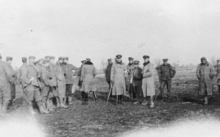*Image Credit: Wikimedia Commons In the midst of the Great War, a simple act of humanity emerged from the trenches of combat on December 24, 1914. The “Christmas Truce,” a temporary demonstration of goodwill and cooperation, spread amongst soldiers from the German and British armies stuck on battlefields far from home for the holidays. Just five months before, hundreds of thousands of young men had been thrust into the ugly reality of World War I. Driven in large part by fervor for their homelands, the soldiers could not have understood how the bloody mess of conflict would change from the regimented battles that had carried on for centuries. With new, more powerful machines — aircraft and tanks, for example — and large armies holding advanced weaponry entering the fray at every turn, the romance was soon lost. On December 7th, Pope Benedict XV called on the participating nations — being Western Europe, all of them had ties to Christianity — to bring a halt to the wanton destruction to celebrate the birth of Jesus Christ, their common Savior. Officials from all sides flatly denied the idea of halting operations for Christmas Day. Fearing an enemy advance despite the bitter conditions along the Western Front, commanders issued orders for troops to dig in for protection and await a change in strategy when the new year arrived. According to tradition, elements of the German Army near Ypres, Belgium tapped into the festive spirit on December 24, 1914 by lighting candles and singing Christmas carols in their trenches. The British, hearing the soft melodies across the field, joined in with some of their favorites. Before long, a handful of men brave enough to risk being shot wandered into No Man’s Land to talk with opposing soldiers. Doing their best to communicate despite differences in language and culture, small gifts were exchanged — often cigarettes or buttons from uniforms — and, in one confirmed case, a soccer game broke out. Given a rest from the possibility of being killed, some worked to recover the bodies of comrades who had fallen on the field, pulling them back behind the lines for burial. Moved by the feeling of mutual loss, a few of the gatherings featured joint funeral services honoring the dead of both sides. The break was, of course, temporary. Officers further up the chain of command were livid when tales of fraternization worked their way to headquarters. Most of the soldiers were back to firing across the breach by the day after Christmas. Friendship would have to wait, if they were lucky enough to survive, for another time and place. The following year, as December 25th neared again, leadership voiced disapproval of communicating with the enemy, threatening severe consequences for soldiers found doing so. In large part, the possibility of a court martial warned most off a repeat of the congeniality exhibited in 1914. Despite artillery bombardments instituted to discourage men from venturing into No Man’s Land in the years that followed, small truces still occurred. The will to “live and let live” — shared almost exclusively by those who were on the lowest rungs of the military ladder — managed to take precedent at Christmastime. Also On This Day: 563 – The massive Christian church Hagia Sophia in Constantinople is rededicated after being destroyed by an earthquake five years before 1777 – James Cook discovers Christmas Island, actually a coral atoll called Kirimati, in the South Pacific 1906 – Reginald Fessenden creates the first radio broadcast in history 1943 – Dwight D. Eisenhower becomes the Supreme Allied Commander for the remainder of World War II 1968 – Apollo 8 becomes the first manned spacecraft to circle the moon, broadcasting its images back to televisions on Earth — one of the most watched programs in history
December 24 1914 – The “Christmas Truce” of World War I Begins
*Image Credit: Wikimedia Commons In the midst of the Great War, a simple act of humanity emerged from the trenches of combat on December 24, 1914. The “Christmas Truce,” a…
350
